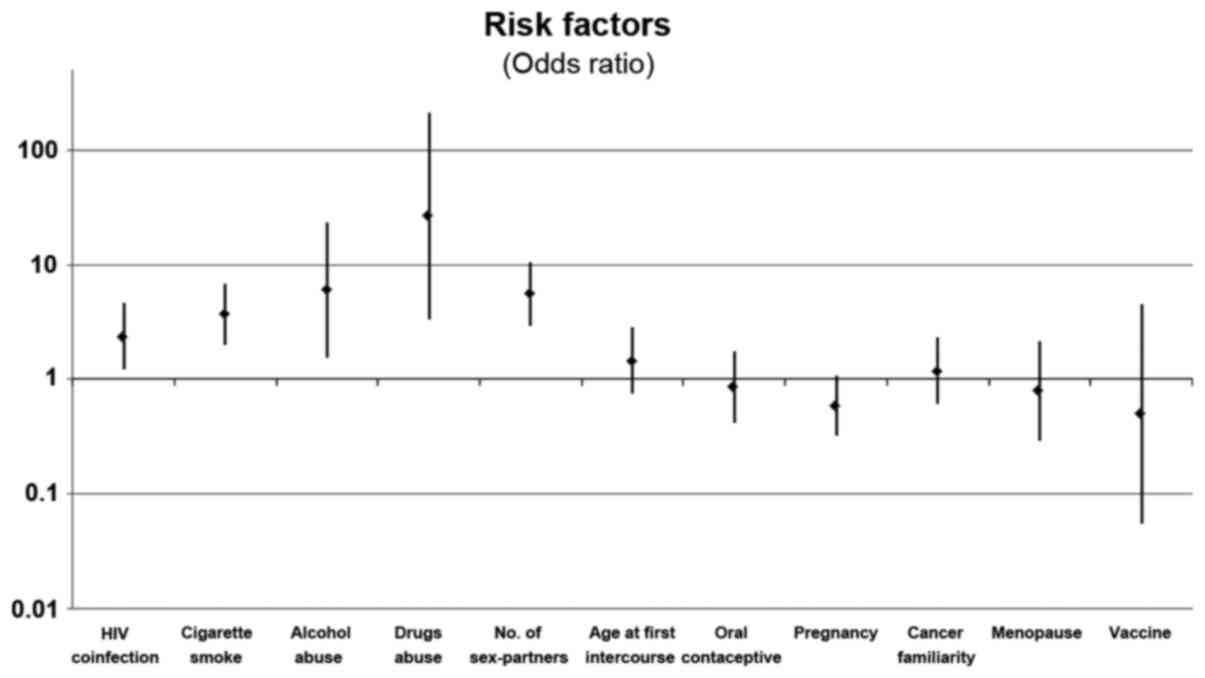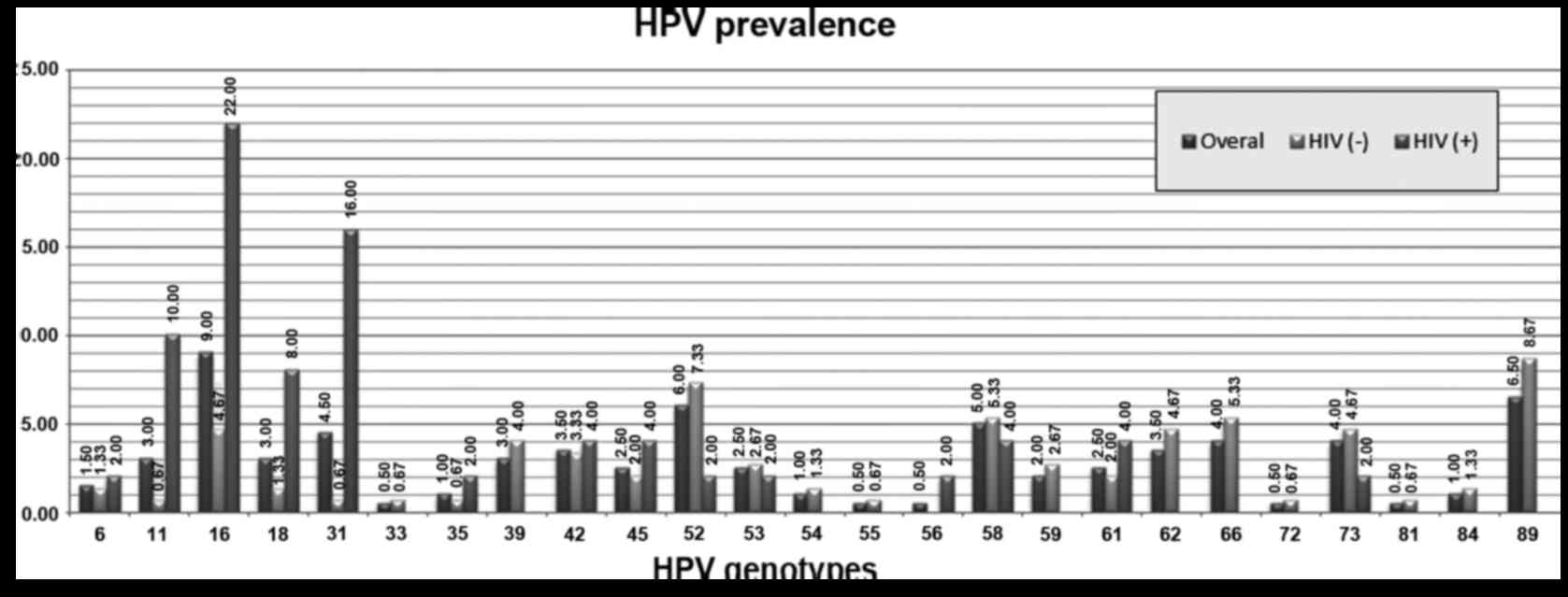|
1
|
Lazarczyk M, Cassonnet P, Pons C, Jacob Y
and Favre M: The EVER proteins as a natural barrier against
papillomaviruses: A new insight into the pathogenesis of human
papillomavirus infections. Microbiol Mol Biol Rev. 73:348–370.
2009. View Article : Google Scholar : PubMed/NCBI
|
|
2
|
Bernard HU, Burk RD, Chen Z, van Doorslaer
K, zur Hausen H and de Villiers EM: Classification of
papillomaviruses (PVs) based on 189 PV types and proposal of
taxonomic amendments. Virology. 401:70–79. 2010. View Article : Google Scholar : PubMed/NCBI
|
|
3
|
de Villiers EM: Cross-roads in the
classification of papillomaviruses. Virology. 445:2–10. 2013.
View Article : Google Scholar : PubMed/NCBI
|
|
4
|
McKenzie ND, Kobetz EN, Ganjei-Azar P,
Rosa-Cunha I, Potter JE, Morishita A, Lucci JA III, Guettouche T,
Hnatyszyn JH and Koru-Sengul T: HPV in HIV-infected women:
Implications for primary prevention. Front Oncol. 4:1792014.
View Article : Google Scholar : PubMed/NCBI
|
|
5
|
Dunne EF, Unger ER, Sternberg M, McQuillan
G, Swan DC, Patel SS and Markowitz LE: Prevalence of HPV infection
among females in the United States. JAMA. 297:813–819. 2007.
View Article : Google Scholar : PubMed/NCBI
|
|
6
|
Tartaglia E, Iafusco D, Galderisi A and
Mastrantonio P: Do HPV vaccine genotypes agree with HPV circulating
types? Lancet Infect Dis. 11:585–586. 2011. View Article : Google Scholar : PubMed/NCBI
|
|
7
|
Tartaglia E, Iafusco D, Cocca A, Palomba
S, Rotondi M and Mastrantonio P: HPV at the time of Vaccine: Has
screening reached its goal? Eur J Gynecol Oncol. 33:591–597.
2012.
|
|
8
|
Franco EL, Villa LL, Sobrinho JP, Prado
JM, Rousseau MC, Désy M and Rohan TE: Epidemiology of acquisition
and clearance of cervical human papillomavirus infection in women
from a high-risk area for cervical cancer. J Infect Dis.
180:1415–1423. 1999. View
Article : Google Scholar : PubMed/NCBI
|
|
9
|
Mbulawa ZZ, Marais DJ, Johnson LF, Coetzee
D and Williamson AL: Impact of human immunodeficiency virus on the
natural history of human papillomavirus genital infection in South
African men and women. J Infect Dis. 206:15–27. 2012. View Article : Google Scholar : PubMed/NCBI
|
|
10
|
Lissouba P, Van de Perre P and Auvert B:
Association of genital human papillomavirus infection with HIV
acquisition: A systematic review and meta-analysis. Sex Transm
Infect. 89:350–356. 2013. View Article : Google Scholar : PubMed/NCBI
|
|
11
|
Filia A: Epidemiological aspects of HPV
infection. (last revision Apr 1, 2015). http://www.epicentro.iss.it/problemi/hpv/epid.aspFeb
23–2015
|
|
12
|
Madeddu G, Mameli G, Capobianco G,
Babudieri S, Maida I, Bagella P, Rocca G, Cherchi PL, Sechi LA,
Zanetti S, et al: HPV infection in HIV-positive females: The need
for cervical cancer screening including HPV-DNA detection despite
successful HAART. Eur Rev Med Pharmacol Sci. 18:1277–1285.
2014.PubMed/NCBI
|
|
13
|
Clifford GM, Goncalves MA and Franceschi
S: HPV and HIV Study Group: Human papillomavirus types among women
infected with HIV: A meta-analysis. AIDS. 20:2337–2344. 2006.
View Article : Google Scholar : PubMed/NCBI
|
|
14
|
Camargo M, Soto-De Leon SC, Munoz M,
Sanchez R, Peña-Herrera D, Pineda-Peña AC, Sussmann O, Paez C,
Perez-Prados A, Patarroyo ME and Patarroyo MA: Human papillomavirus
detection in women with and without human immunodeficiency virus
infection in Colombia. BMC Cancer. 14:4512014. View Article : Google Scholar : PubMed/NCBI
|
|
15
|
Muñoz N, Castellsagué X, de González AB
and Gissmann L: HPV in the etiology of human cancer. Vaccine. 24
Suppl 3:S3/1–10. 2006. View Article : Google Scholar
|
|
16
|
Calvo M, Laguno M, Martínez M and Martínez
E: Effects of tobacco smoking on HIV-infected individuals. AIDS
Rev. 17:47–55. 2015.PubMed/NCBI
|
|
17
|
Cotton SC, Sharp L, Seth R, Masson LF,
Little J, Cruickshank ME, Neal K and Waugh N: TOMBOLA Group:
Lifestyle and socio-demographic factors associated with high-risk
HPV infection in UK women. Br J Cancer. 97:133–139. 2007.
View Article : Google Scholar : PubMed/NCBI
|
|
18
|
Green J, de Gonzalez Berrington A, Smith
JS, Franceschi S, Appleby P, Plummer M and Beral V: Human
papillomavirus infection and use of oral contraceptives. Br J
Cancer. 88:1713–1720. 2003. View Article : Google Scholar : PubMed/NCBI
|
|
19
|
Silva Ld, Miranda A, Batalha R, Ferreira
L, Santos M and Talhari S: High-risk human papillomavirus and
cervical lesions among women living with HIV/AIDS in Brazilian
Amazon, Brazil. Braz J Infect Dis. 19:557–562. 2015. View Article : Google Scholar : PubMed/NCBI
|
|
20
|
Denny LA, Franceschi S, de Sanjosé S,
Heard I, Moscicki AB and Palefsky J: Human papillomavirus, human
immunodeficiency virus and immunosuppression. Vaccine. 30 Suppl
5:F168–F174. 2012. View Article : Google Scholar : PubMed/NCBI
|
|
21
|
Rositch AF, Gravitt PE, Tobian AA, Newell
K, Quinn TC, Serwadda D, Ssebbowa P, Kiggundu V, Gray RH and
Reynolds SJ: Frequent detection of HPV before and after initiation
of antiretroviral therapy among HIV/HSV-2 co-infected women in
Uganda. PLoS One. 8:e553832013. View Article : Google Scholar : PubMed/NCBI
|
|
22
|
Hong H, He TF, Ni HX, Zhang S and Xu GZ:
Prevalence and genotype distribution of HPV infection among women
in Ningbo, China. Int J Gynaecol Obstet. 131:96–99. 2015.
View Article : Google Scholar : PubMed/NCBI
|
|
23
|
Sammarco ML, Ucciferri C, Tamburro M,
Falasca K, Ripabelli G and Vecchiet J: High prevalence of human
papillomavirus type 58 in HIV infected men who have sex with men: A
preliminary report in Central Italy. J Med Virol. 88:911–914. 2016.
View Article : Google Scholar : PubMed/NCBI
|
|
24
|
Liu G, Markowitz LE, Hariri S, Panicker G
and Unger ER: Seroprevalence of 9 human papillomavirus types in the
United States, 2005–2006. J Infect Dis. 213:191–198. 2016.
View Article : Google Scholar : PubMed/NCBI
|
|
25
|
Petrosky E, Bocchini JA Jr, Hariri S,
Chesson H, Curtis CR, Saraiya M, Unger ER and Markowitz LE: Centers
for Disease Control and Prevention (CDC): Use of 9-valent human
papillomavirus (HPV) vaccine: Updated HPV vaccination
recommendations of the advisory committee on immunization
practices. MMWR Morb Mortal Wkly Rep. 64:300–304. 2015.PubMed/NCBI
|
|
26
|
Chesson HW, Laprise JF, Brisson M and
Markowitz LE: Impact and cost-effectiveness of 3 doses of 9-Valent
human papillomavirus (HPV) vaccine among US females previously
vaccinated with 4-valent HPV vaccine. J Infect Dis. 213:1694–1700.
2016. View Article : Google Scholar : PubMed/NCBI
|
|
27
|
Brisson M, Laprise JF, Chesson HW, Drolet
M, Malagón T, Boily MC and Markowitz LE: Health and economic impact
of switching from a 4-valent to a 9-valent HPV vaccination program
in the United States. J Natl Cancer Inst. 108:pii: djv282.
2015.PubMed/NCBI
|
|
28
|
Kojic EM, Rana AI and Cu-Uyin S: Human
papillomavirus vaccination in HIV-infected women: Need for
increased coverage. Expert Rev Vaccines. 15:105–117. 2016.
View Article : Google Scholar : PubMed/NCBI
|
|
29
|
Zhai L and Tumban E: Gardasil-9: A global
survey of projected efficacy. Antiviral Res. 130:101–109. 2016.
View Article : Google Scholar : PubMed/NCBI
|











